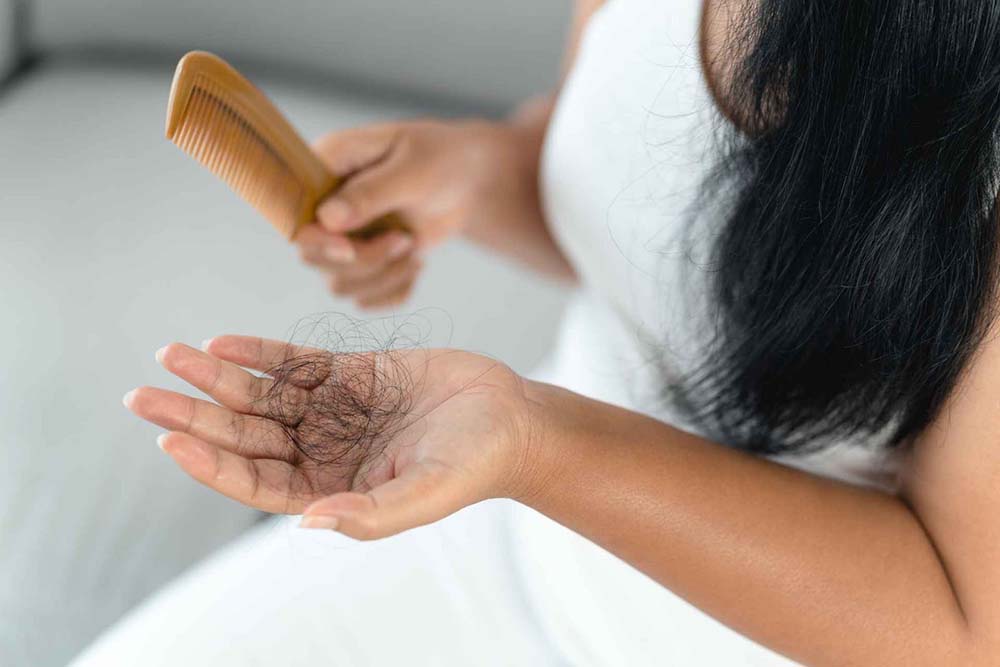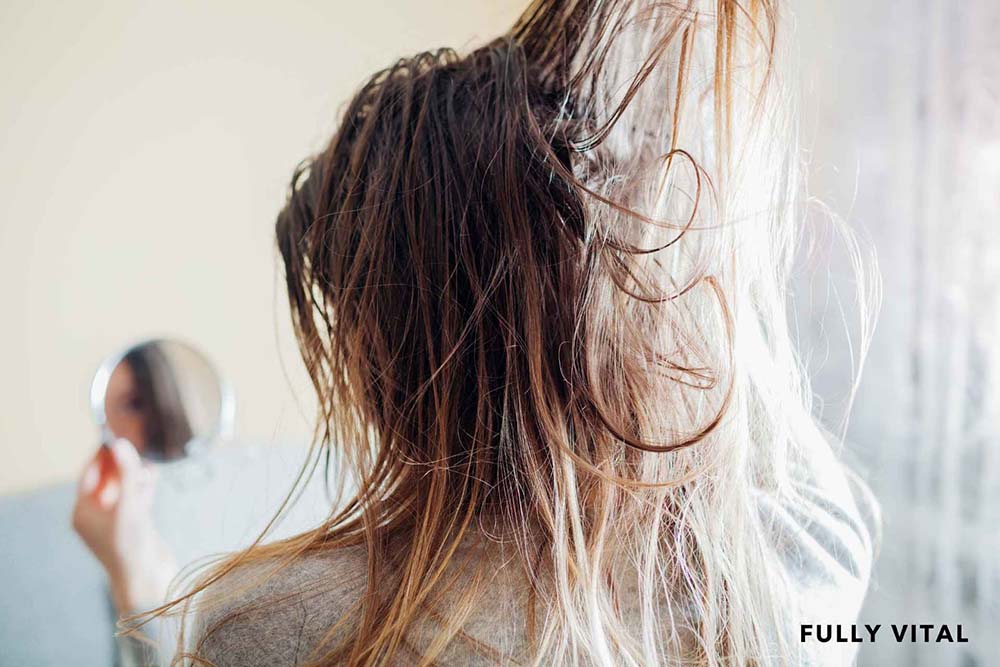
When is Hair Loss Normal and How Can We Treat It?
Are you finding more hair on your brush or in the shower drain?
Before you hit the panic button, let's talk about hair loss.
Whether you have flowing locks or a trendy short cut, hair loss is a concern that affects us all.
In this article, we'll dive into the world of hair loss, what's considered normal, and how you can address it while embracing your unique beauty.

I LOVE MY HAIR NOW
FullyVital hair serum and hair vitamins made tremendous improvements in my hair. I truly love my hair now.
Dorit S.,
Identifying Excessive Hair Loss
Understanding whether your hair loss is within the normal range or if it's crossing into excessive territory can be a crucial step in addressing the issue.1
Hair shedding is a natural part of the hair growth cycle, but when does it become a cause for concern?
Let's delve deeper into how to identify excessive hair loss and when it might be time to seek professional advice.

Average Hair Loss In Men And Women
Both men and women experience hair shedding, but the patterns can differ.
Men often face receding hairlines and bald spots, while women may notice widening part lines and overall thinning.
The key is understanding what's typical for your gender and age group.
However, determining if your hair loss is excessive goes beyond simple patterns. Here are some factors to consider:
Hair Density
Pay attention to the density of your hair.
If you notice a significant reduction in the volume of your hair over time, it could be a sign of excessive hair loss.
Hairbrush and Shower Drain
It's common to find a few strands of hair in your hairbrush or shower drain.
However, if you notice clumps of hair or a substantial increase in the amount of hair left behind, it might be time to investigate further.
Receding Hairline
In men, a receding hairline is a common sign of hair loss.
If your hairline is gradually moving backward, it could indicate excessive shedding.
Widening Part Line
For women, a widening part line or visible scalp can be indicative of excessive hair loss.
If your part appears wider than usual, it's worth exploring the cause.
Thinning Areas
Keep an eye on specific areas of your scalp that might be thinning more than others.
Thinning patches or bald spots could be red flags for excessive hair loss.

When to Seek Professional Advice
If you're concerned about the amount of hair you're losing or if you're noticing any of the signs mentioned above, it's advisable to consult a dermatologist or a trichologist.
These professionals specialize in hair and scalp health and can provide personalized assessments of your situation.
They might perform tests to determine the underlying causes of your hair loss, such as blood tests, scalp examinations, and possibly even biopsies.2
Treating And Preventing Hair Loss
If you find yourself losing more hair than you'd like, don't fret.
There are steps you can take to promote healthy hair growth and tackle excessive hair loss head-on:
-
Nourish from Within: Your hair's health reflects your overall well-being.
-
A balanced diet rich in vitamins and minerals, particularly vitamins A, C, and E, biotin, and iron, can give your hair the nutrients it needs to thrive.
-
Stay Hydrated: Drinking enough water is not only good for your body but also for your hair.
Proper hydration helps maintain hair's elasticity and prevents brittleness. -
Gentle Hair Care: Treat your hair with care.
Avoid aggressive brushing, tight hairstyles, and excessive heat styling, as they can damage your hair and lead to breakage. -
Explore Hair Growth Products: Hair growth products containing ingredients like minoxidil can stimulate hair follicles and encourage regrowth.
Consult a professional before starting any new regimen. -
Stress Management: Chronic stress can wreak havoc on your hair. Incorporate stress-reducing activities such as yoga, meditation, or simply taking time for yourself into your routine.3
-
Seek Professional Advice: If you're concerned about your hair loss, consult a dermatologist or a trichologist.
They can identify the underlying causes and recommend appropriate treatments.
Hair Falling Out While Brushing
It's not uncommon to see a few strands of hair in your brush after grooming.
In fact, brushing helps distribute natural oils and can stimulate blood flow to the scalp, promoting healthy hair growth.
However, if you're noticing excessive hair loss while brushing, it might be time to reevaluate your hair care routine and other lifestyle factors.
Hair Falling Out While Washing
Hair shedding during washing is also a common occurrence.
When hair is wet, it's more fragile and prone to breakage. To minimize hair loss during washing:
-
Opt for a mild, sulfate-free shampoo.
-
Gently massage your scalp without vigorous rubbing.
-
Detangle your hair before washing to reduce knots and tangles post-shower.
What Is Hair Loss?
Hair loss, scientifically known as alopecia, refers to the gradual or sudden loss of hair from the scalp or other parts of the body.
It's a common concern that affects both men and women, and it can vary in severity from mild thinning to significant balding.
Understanding the basics of hair loss can help you take proactive steps to manage and address it.
How Much Hair Loss Is Normal?
Hair loss is a natural part of the hair growth cycle.
On average, individuals lose approximately 50 to 100 hairs per day.
This shedding is part of the body's renewal process and usually goes unnoticed.
However, if you're concerned about excessive hair loss, it's essential to pay attention to patterns and changes in your hair density.
How Does Hair Loss Work?
Hair loss occurs due to disruptions in the hair growth cycle. This cycle involves three main phases:
-
Anagen Phase: The active growth phase, during which hair follicles produce new hair.
-
Catagen Phase: A transitional phase when hair growth slows down.
-
Telogen Phase: The resting phase, in which old hairs are shed and new ones start growing.
Various factors, including genetics, hormones, and external stressors, can affect the duration and intensity of each phase, leading to hair loss.
What Causes Hair Loss?
Several factors can contribute to hair loss:
Genetics
Family history plays a significant role.
If your parents or grandparents experienced hair loss, you might be more prone to it.
Hormones
Hormonal changes due to pregnancy, menopause, or conditions like polycystic ovary syndrome (PCOS) can trigger hair loss.
Medical Conditions
Certain medical conditions like thyroid disorders, autoimmune diseases, and alopecia areata can lead to hair loss.
Medications
Some medications, such as chemotherapy drugs and certain antidepressants, can cause hair loss as a side effect.
Poor Diet and Nutrition
Inadequate intake of essential nutrients can weaken hair follicles and contribute to hair loss.
Stress
Chronic stress can disrupt the hair growth cycle and lead to excessive shedding.
What Are The Downsides To Too Much Hair Loss?
Experiencing too much hair loss can have several negative effects:
Diminished Self-Confidence
Hair loss can impact self-esteem and body image, leading to reduced self-confidence.
Emotional Distress
Excessive hair loss may cause emotional distress, anxiety, and even depression in some individuals.
Social Impact
Hair loss can affect how you're perceived by others, potentially influencing social interactions.
Limited Styling Options
Thinning hair might limit your ability to style your hair as you desire.
Sensitivity to Weather
With less hair to protect the scalp, those experiencing significant hair loss might be more sensitive to extreme temperatures.
What Are The Alternatives To Hair Loss?
If you're concerned about hair loss, you're not alone.
There are various alternatives and treatments available to address the issue:
Topical Treatments
Over-the-counter or prescription topical solutions like minoxidil can promote hair growth and slow down further loss.
Oral Medications
Prescription medications like finasteride can help manage hair loss by targeting hormone-related factors.
Hair Growth Devices
Laser combs and helmets can stimulate hair follicles and encourage regrowth.
Platelet-Rich Plasma (PRP) Therapy
This procedure involves injecting your own platelet-rich plasma into the scalp to promote hair growth.
Hair Transplants
Surgical procedures like hair transplantation can restore lost hair by moving hair follicles from one area to another.
Lifestyle Changes
Adopting a healthier lifestyle through balanced nutrition, stress management, and proper hair care can contribute to maintaining healthy hair.
Experience Youthful Hair with Fully VitalDiscover the secret to maintaining vibrant, youthful hair with Fully Vital's innovative hair growth products. Say goodbye to worries about hair loss and aging locks, and embrace a healthier relationship with your hair. Our mission is to empower you with science-backed solutions that truly make a difference. Key Features:
Experience the transformation and unlock the potential of your hair with Fully Vital. Elevate your hair care routine and embrace the journey to healthier, more vibrant hair today! |
Final Thoughts On How Much Hair Loss Is Normal
In conclusion, understanding the nuances of hair loss is vital for maintaining healthy, vibrant locks. While shedding a certain amount of hair each day is a natural part of the hair growth cycle, excessive hair loss can be a cause for concern.
By recognizing the signs of hair loss, seeking professional advice when necessary, and adopting healthy lifestyle practices, you can promote optimal hair health and manage any challenges that arise.
Remember, your hair is a reflection of your overall well-being, and taking proactive steps to care for it can lead to positive outcomes.
Whether you're a man or woman, embracing your natural beauty and exploring effective solutions is key to feeling confident and comfortable in your own skin.
If you're looking for ways to support your hair health journey, consider exploring the range of hair growth products available.
At Fully Vital, we offer a variety of hair growth solutions designed to help you maintain a healthy relationship with your locks and prevent the signs of aging hair. Take the next step in your hair care journey and discover how you can nurture your hair to its fullest potential.
Frequently Asked Questions About How Much Hair Loss Is Normal
Is it normal to lose hair every day?
Yes, it's perfectly normal to lose around 50 to 100 hairs daily as part of the natural hair growth cycle.
Can a poor diet cause hair loss?
Absolutely, a diet lacking essential nutrients can contribute to hair loss.
Ensure your meals are rich in vitamins and minerals for optimal hair health.
Is hair loss only experienced with age?
No, hair loss can occur at any stage of life due to various factors such as genetics, hormonal changes, and lifestyle.
Do natural remedies effectively treat hair loss?
While scientific evidence is limited, some natural remedies like rosemary oil and saw palmetto might aid hair growth for certain individuals.
How long should I use a hair growth product before expecting results?
Patience is key when using hair growth products. Results may take several months, and consistency is crucial for success.
Keep in mind that individual results can vary.
Can stress contribute to hair loss?
Absolutely, chronic stress can lead to increased hair shedding.
Incorporating stress-reduction techniques into your routine can help minimize its impact on your hair.
Are there supplements that promote hair growth?
While supplements claiming to promote hair growth are widely available, their effectiveness varies.
Some supplements contain vitamins and minerals that support hair health, such as biotin, vitamin D, and iron. However, the impact of these supplements can differ based on individual nutritional needs.
Consult a healthcare professional before adding supplements to your routine to ensure they are safe and appropriate for you.
Can I prevent genetic hair loss?
Genetic or hereditary hair loss, also known as androgenetic alopecia, can be challenging to prevent entirely.
However, you can take steps to slow down its progression and maintain the health of your existing hair:
-
Early Intervention: If you have a family history of hair loss, consider starting treatments early to manage the condition.
-
Medications: Prescription medications like finasteride can help slow down the progression of genetic hair loss.
-
Healthy Lifestyle: Maintaining a balanced diet, managing stress, and adopting a proper hair care routine can contribute to healthier hair.
Does frequent washing lead to hair loss?
Frequent washing alone is unlikely to cause significant hair loss.
However, using harsh shampoos, hot water, and vigorous rubbing can weaken hair and contribute to breakage.
To minimize the impact of washing on hair health:
-
Use Gentle Products: Opt for mild, sulfate-free shampoos and conditioners that are gentle on your hair and scalp.
-
Avoid Hot Water: Wash your hair with lukewarm water to prevent excessive drying and damage.
-
Be Gentle: Massage your scalp and hair with care, avoiding rough rubbing that can lead to breakage.
Is it normal to lose hair after giving birth?
Yes, it's common for some women to experience hair loss after giving birth.
During pregnancy, hormonal changes can lead to thicker hair, but after childbirth, hormone levels normalize, and hair that was in the growth phase shifts to the shedding phase.
This can result in temporary hair loss, often starting a few months postpartum.
This condition is known as postpartum telogen effluvium, and hair typically regrows within a year.
Can frequent coloring or bleaching cause hair loss?
Frequent coloring or bleaching can weaken hair and make it more susceptible to breakage, but it typically doesn't cause permanent hair loss.
However, aggressive chemical treatments can damage hair follicles and lead to temporary shedding. To minimize the impact:
-
Space Out Treatments: Avoid frequent color or bleach applications to give your hair time to recover.
-
Use Quality Products: Opt for professional-grade hair color products and follow proper aftercare routines.
-
Deep Conditioning: Regularly use deep conditioning treatments to nourish and strengthen your hair.
Sources:
-
Hair Loss: Causes, Treatments and Prevention Options. (n.d.). Cleveland Clinic. https://my.clevelandclinic.org/health/diseases/21753-hair-loss
-
Hair loss: Diagnosis and treatment. (n.d.). Www.aad.org. https://www.aad.org/public/diseases/hair-loss/treatment/diagnosis-treat
-
Mayo Clinic Staff. (2020, August 18). Exercise and stress: Get moving to manage stress. Mayo Clinic. https://www.mayoclinic.org/healthy-lifestyle/stress-management/in-depth/exercise-and-stress/art-20044469







